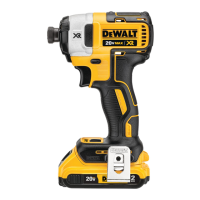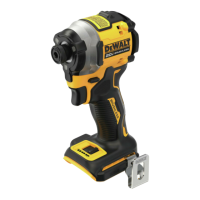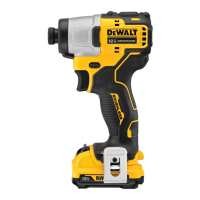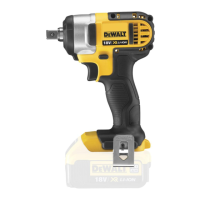10
ENGLISH
Fuel Gauge Battery Packs (Fig.B)
Some DeWALT battery packs include a fuel gauge which
consists of three green LED lights that indicate the level of
charge remaining in the batterypack.
To actuate the fuel gauge, press and hold the fuel gauge
button
13
. A combination of the three green LED lights will
illuminate designating the level of charge left. When the level
of charge in the battery is below the usable limit, the fuel gauge
will not illuminate and the battery will need to berecharged.
NOTE: The fuel gauge is only an indication of the charge left on
the battery pack. It does not indicate tool functionality and is
subject to variation based on product components, temperature
and end‑userapplication.
Belt Hook (Optional Accessory) (Fig. A)
WARNING: To reduce the risk of serious personal
injury, turn tool off and disconnect battery pack
before making any adjustments or removing/
installing attachments oraccessories.
WARNING: To reduce the risk of serious personal
injury, DO NOT suspend tool overhead or suspend
objects from the belt hook. ONLY hang tool’s belt hook
from a workbelt.
WARNING: To reduce the risk of serious personal
injury, ensure the screw holding the belt hook issecure.
CAUTION: To reduce the risk of personal injury or
damage, DO NOT use the belt hook to hang the drill
while using as aspotlight.
IMPORTANT: When attaching or replacing the belt hook, use
only the screw
9
that is provided. Be sure to securely tighten
thescrew.
The belt hook
8
can be be attached to either side of the tool
using only the screw
9
provided, to accommodate left‑ or
right‑ handed users. If the hook is not desired at all, it can be
removed from thetool.
To move belt hook, remove the screw
9
that holds it in place
then reassemble on the opposite side. Be sure to securely
tighten thescrew.
Variable Speed Trigger Switch (Fig. A)
To turn the tool on, squeeze the trigger switch
1
. To turn the
tool off, release the trigger switch. Your tool is equipped with
a brake. The anvil will stop when the trigger switch is fully
released. The variable speed switch enables you to select the
best speed for a particular application. The more you squeeze
the trigger, the faster the tool will operate. For maximum tool
life, use variable speed only for starting holes orfasteners.
NOTE: Continuous use in variable speed range is not
recommended. It may damage the switch and should
beavoided.
Forward/Reverse Control Button (Fig. A)
A forward/reverse control button
2
determines the direction of
the tool and also serves as a lock‑offbutton.
To select forward rotation, release the trigger switch and
depress the forward/reverse control button on the right side of
thetool.
To select reverse, release the trigger switch and depress the
forward/reverse control button on the left side of thetool.
The centre position of the control button locks the tool in the off
position. When changing the position of the control button, be
sure the trigger isreleased.
NOTE: The first time the tool is run after changing the direction
of rotation, you may hear a click on start up. This is normal and
does not indicate aproblem.
Worklights (Fig. A, C)
The worklights
(
6
)
are activated when the variable
speed trigger
(
1
)
is depressed. Pressing the worklight
switch
(
11
)
repeatedly will cycle through low illumination, high
illumination, and off.
NOTE: The worklights are for lighting the immediate work
surface and is not intended to be used as aflashlight.
Mode Selector (Fig. C)
Your tool is equipped with a mode selector
(
7
)
which allows you
to select one of four modes.
Select the mode based on the application and control the speed
of the tool using the variable speed trigger
1
.
Timber Screw™ Mode (Fig. C)
DCF922
Timber Screw™ mode optimises tool performance to help
increase the speed of fastening applications in wood using lag
bolts, lag screws and structural wood screws.
Scaffolding Mode (Fig. C)
DCF921
Your tool is equipped with a mode designed for scaffolding
applications. In forwards rotation it will run down the nut on
the scaffold clamp and then impact for a period of time before
cutting off to avoid over tightening of the fastener. In reverse
rotation it will impact to break the nut free, before winding
down the nut and cutting off after a period of time to limit
damage to clamps.
NOTE: Always check scaffolding clamps are tightened correctly
with a torque wrench.
Precision Wrench™ Mode(Fig. C)
In addition to low speed impacting modes, this tool features
the Precision Wrench™ mode which grants the user greater
control in both fastening and loosening applications. When set
in forward, the tool will fasten at 2500 RPM until impact begins.
The tool will then pause for 0.5 seconds before continuing
to impact at a rate of 3550 IPM, providing the user with
greater control and reducing the chance of overtightening or
damagingmaterial.

